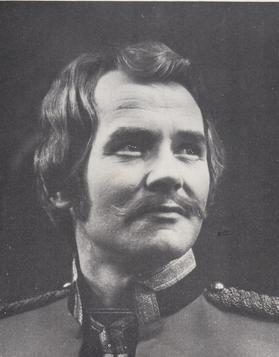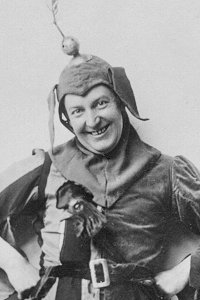
The Royal Variety Performance is a televised variety show held annually in the United Kingdom to raise money for the Royal Variety Charity. It is attended by senior members of the British royal family. The evening's performance is presented as a live variety show, usually from a theatre in London and consists of family entertainment that includes comedy, music, dance, magic and other speciality acts.

The Gondoliers; or, The King of Barataria is a Savoy Opera, with music by Arthur Sullivan and libretto by W. S. Gilbert. It premiered at the Savoy Theatre on 7 December 1889 and ran for a very successful 554 performances, closing on 30 June 1891. This was the twelfth comic opera collaboration of fourteen between Gilbert and Sullivan.

Sir Augustus Henry Glossop Harris was a British actor, impresario, and dramatist, a dominant figure in the West End theatre of the 1880s and 1890s.

The D'Oyly Carte Opera Company is a professional British light opera company that, from the 1870s until 1982, staged Gilbert and Sullivan's Savoy operas nearly year-round in the UK and sometimes toured in Europe, North America and elsewhere. The company was revived for short seasons and tours from 1988 to 2003, and since 2013 it has co-produced four of the operas with Scottish Opera.

Sir Henry Lytton was an English actor and singer who was the leading exponent of the starring comic patter-baritone roles in Gilbert and Sullivan operas from 1909 to 1934. He also starred in musical comedies. His career with the D'Oyly Carte Opera Company spanned 50 years, and he is the only performer ever knighted for achievements in Gilbert and Sullivan roles.

Jessie Charlotte Bond was an English singer and actress best known for creating the mezzo-soprano soubrette roles in the Gilbert and Sullivan comic operas. She spent twenty years on the stage, the bulk of them with the D'Oyly Carte Opera Company.

Kenneth Sandford was an English singer and actor, best known for his performances in baritone roles of the Savoy Operas of Gilbert and Sullivan.
Robert Meadmore is a British singer and actor.

Charles Courtice Pounds, better known by the stage name Courtice Pounds, was an English singer and actor known for his performances in the tenor roles of the Savoy Operas with the D'Oyly Carte Opera Company and his later roles in Shakespeare plays and Edwardian musical comedies.

Fred Billington was an English singer and actor, best known for his performances in baritone roles of the Savoy Operas with the D'Oyly Carte Opera Company. His career with the company began in 1879 and continued with brief interruptions until his death in 1917.

Leonard Osborn was an English opera singer and actor, best known for his portrayal of the tenor roles in the Savoy Operas with the D'Oyly Carte Opera Company. An accomplished actor and dancer, he later became a stage director for the company.

Alexander Meston Reid , better known as Meston Reid, was a Scottish opera singer and actor, best known for his performances in tenor roles of the Savoy Operas with the D'Oyly Carte Opera Company. After working his way up through the ranks for four years with Sadler's Wells Opera and on tour, Reid joined D'Oyly Carte as one of the company's principal tenors, where he eventually played most of the leading tenor roles in the Gilbert and Sullivan operas until the company closed in 1982. He continued to sing and direct until his sudden death in 1993.

Patricia Leonard was an English opera singer, best known for her performances in mezzo-soprano and contralto roles of the Savoy Operas with the D'Oyly Carte Opera Company.

The Story of Gilbert and Sullivan is a 1953 British musical drama film dramatisation of the collaboration between Gilbert and Sullivan. Librettist W. S. Gilbert and composer Arthur Sullivan, portrayed by Robert Morley and Maurice Evans, co-wrote fourteen extraordinarily successful comic operas, later referred to as the Savoy Operas, which continue to be popular today.

Hugh Enes Blackmore was a British opera and concert singer and actor. Known as the "Iron-Throated Tenor", he is best remembered for his performances of tenor roles with the D'Oyly Carte Opera Company. His career with D'Oyly Carte spanned almost 30 years, ending with a season as the company's stage manager. He was later a teacher of operatic singing and acting.

Webster Booth was an English tenor, best remembered as the duettist partner of Anne Ziegler. He was also one of the finest tenors of his generation and was a distinguished oratorio soloist.

Lyndsie Holland was an English opera singer and actress known for her performances in the contralto roles of the Savoy Operas.

Charles Roby Walenn was an English singer and actor, best known for his performances in the comic baritone roles of the Gilbert and Sullivan operas with touring companies of the D'Oyly Carte Opera Company from 1887 to 1909 and later, off and on through the 1920s, with J. C. Williamson in Australia. Later in his career, he became known for London engagements in the title role of Rev. Spalding in The Private Secretary, which he first played at the Savoy Theatre in 1917, where he had never performed in the Savoy operas.

Charles Groves was an Irish-born, British stage actor of the Victorian era, associated with his work in comedy in London's West End and on Broadway.


















